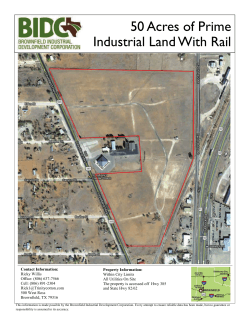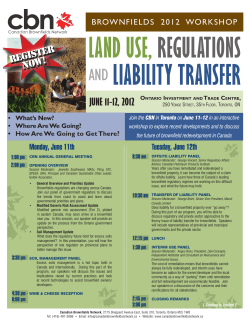
Rebalancing the planning system: Giving communities a genuine
Rebalancing the planning system: Giving communities a genuine voice A manifesto for planning reform 2015 Thanks to the following organisations for their views in helping to form this manifesto: Rebalancing the planning system: Giving communities a genuine voice A manifesto for planning reform 2015 Foreword Britain’s goal to build more homes, especially affordable ones, is one that many of us would support. However it is a goal that needs to be properly thought through- councils need to work together, our green spaces must be protected and we must encourage development particularly on brownfield sites. There are also instances where developers seem to have a greater say than the communities amongst whom they are seeking to build, so at the heart of the planning system we need local people feeling empowered to have a say in the future of their towns and cities. Last year, I introduced the National Planning Policy Framework (Community Involvement) Bill in the House of Commons to raise the profile of these very issues and the importance of addressing them sooner rather than later. I later chaired a parliamentary roundtable bringing together MPs, campaigners and community groups to produce a manifesto setting out solutions- solutions that are in the genuine spirit of localism and giving power back to our communities This is exactly what government must do if it truly means ‘to help people and their locally elected representatives to achieve their own ambitions.’ This is our manifesto. Greg Mulholland MP 27th March 2015 Introduction ‘We think that the best means of strengthening society is not for central government to try and seize all the power and responsibility for itself. It is to help people and their locally elected representatives to achieve their own ambitions.’ -Rt Hon. Greg Clark MP, Minister of State for Decentralisation (Nov 2011) Government’s stated aim to put more power in the hands of local people is a welcome one. To finally let communities control the development they might be facing, and to empower them to shape their areas are both outcomes of genuine localism. To enable this to happen, however, requires giving people the tools they need. Such tools can range from ensuring planning regulations are weighted in favour of residents rather than developers, making it easy for residents from all walks of life to participate in the planning process, supporting people in putting together their own plans for an area, helping them protect much-valued local facilities from unwanted development, and a raft of other measures. The points set out in this manifesto arose from a parliamentary roundtable last year bringing together a cross-party group of MPs and a wide range of organisations interested in planning. These are the reforms the next government must look at if it wants to edge ever closer to seeing communities truly shape their own neighbourhoods. 1. A genuine and effective series of ‘brownfield first’ policies to deliver building on brownfield sites before green field and Green Belt sites Incentives for a stronger ‘brownfield first’ approach are needed. The NPPF does not give enough support to prioritising building and development on brownfield sites. Government has said it wants to see permissions for homes in place on 90% of suitable brownfield land by 2020, ie. 200,000 homes, but this is well below what could be done- there is enough brownfield land in England to accommodate at least 1.5 million new homes. Government must firstly help fund infrastructure, in return for guarantees of how many homes on brownfield late will be built within the year, with penalty payments imposed for slow development. With brownfield sites sometimes being very costly to redevelop, government must also put forward a programme of financial incentives to help councils and developers in remediating brownfield sites. Key changes we are calling for: • Government should help fund additional infrastructure in exchange for guarantees of the number of homes to be built on brownfield sites within the year. • Government must also set out financial incentives to encourage development on brownfield sites, given the often greater costs of doing so. This could include loan guarantees, tax incentives and deregulating where appropriate. • The NPPF should also be amended to require brownfield sites to be developed before greenfield, and that local authorities can control the order in which planning permission is given in order to make sure this happens. Currently the re use of brownfield land is only ‘encouraged’ and developers can get permission for more attractive greenfield sites if they can show that a local authority has not granted enough planning permissions to provide a five year supply of sites. • Green Belt policy should be tightened and re-affirmed so that boundaries should only be changed in genuinely ‘exceptional circumstances’, and the need for economic growth should not in itself be considered an ‘exceptional circumstance’. 2. End the land banking We need disincentives to dissuade developers from ‘landbanking’ brownfield sites, which they sometimes do to then push for permission. Land banking- the practice of developers hoarding land and waiting to build until house prices have risen- needs to be strongly discouraged. A land value tax would disincentivise land banking, leaving properties empty and would ensure people also paid for the increased value to their homes as a result of improved local infrastructure. Similarly, land which already has planning permission must be counted as part of a council’s five-year land supply. Key changes we are calling for: • Introduce a land value tax to disincentivise land banking. LVT in its classic form is a tax on the annual rental value of all land, ignoring buildings and other developments, the valuation being on the assumption that the land is at its optimum use. • A council’s five-year land supply must include land that already has planning permission. 3. Give Local Plans a chance Where local plans are not in place and still being put together, many communities are having to fight off speculative planning applications from developers. While the local plans are being put together, councils must be enabled to reject developers’ planning applications on grounds of prematurity without fear of legal challenge. There also needs to be a moratorium on building on greenfield sites until these local plans are firmly in place. To further tackle developers not acting responsibly towards local communities, as recommended by the House of Commons’ Communities and Local Government Select Committee, the NPPF must be amended to include a section on the expected responsibilities of developers and how communities could hold developers to account. Key changes we are calling for: • Allow councils to reject planning applications on grounds of prematurity without fear of legal challenge through changes in the Planning Practice Guidance. • • Allow moratoriums on building on greenfield ties until local plans are in place. Amend the NPPF to also set out the expected responsibilities of developers and how they can be held to account by communities. • Introduce a community right of appeal against speculative development in areas where a neighbourhood plan has been prepared. This would allow parish councils, local councillors, NGOs or neighbourhood groups to appeal against decisions to approve planning applications that are not in line with a neighbourhood plan that has either been completed or consulted on. There should be a flat fee of just over £40 to appeal, and community appeals should generally be conducted by written representations or a hearing in order to minimise costs to communities and local authorities. Costs should not be awarded unless there has been unreasonable behaviour. 4. Better engagement with local people When supposed to be constructively consulting local communities, developers sometimes treat members of local communities appallingly, on occasion being intimidating and deliberately baffling. The planning process therefore needs to be friendlier and easier for local people to engage with- so accessibility must be the absolutely key ingredient when developers are engaging with communities. In fact, the whole process should go one step further and talk about “participation” rather than “consultation”. With many local people finding the questioning and discussions at these sessions to be shrouded in ‘legalese’ and technical language, which itself also contributes to the often intimidating nature of these sessions, strong consideration must be given to enabling people to participate through a variety of means. Such means could include- with this by no means being an exhaustive list- a greater emphasis on written submissions, roundtables, drop-in sessions, online discussions, one-on-one meetings. Informal means should not be seen as contradictory to the rigour with which key issues must be discussed. Key changes we are calling for: • The planning process must be made friendlier and easier for local people to engage with. We need to see a greater diversity of methods through which communities are engaged with planning applications, whether online or physically, at optimal times of a week, plain and simple language, in welcoming environments, with council officers and developers proactively looking to help local residents through the process. Planning applications should face a stronger assessment on the extent of their engagement with local communities. • We should also replace plans panels with equitable planning hearings with an independent chair, ie. replace council planning panels with a genuine process of community and councillor involvement. Plans panels are currently a quasi-judicial process that break every simple norm of any fair or just process. In Leeds, developer proposals are actually presented by the Council officers (which is wholly inappropriate) and given considerable time and visuals. On the other hand, the community is allowed two speakers allowed to speak for a derisory and utterly tokenistic three minutes each. It is a fig leaf, to give the impression that the community has a say, but by existing in that format is actually denying any real opportunity for the community to present its objections. 5. Greater protection for local assets and a real right to buy Communities are sometimes left feeling that there was not enough protection in place for key assets that add value to the local area, whether this value is historical, social, economic or otherwise. Government will point to the four Community Rights within the Localism Act 2011 to show that it has taken action. However, these initiatives are not perfect. For example, as part of the Community Right to Bid in order to ‘pause’ the sale of a local asset so the community has time to put together its own bid, the asset must first go through the process of getting listed as an Asset of Community Value (ACV). However, a key flaw with the ACVs scheme is that once the six-month ‘pause’ of sale is over, the property owner can still choose to sell the asset to his preferred bidder of choice. Government must look at the Scottish model, where the local community gets right of first refusal for ACVs being put up for sale. This would give communities across England and Wales a genuine right to buy. Likewise, permitted development rights allow key local assets such as pubs to be targeted by developers because converting them into certain other uses or demolishing them does not require planning permission. This often happens without local communities getting any sort of say in the loss of such key local facilities. Government’s recent concession that permitted development rights will be removed from pubs that get listed as ACVs is a step in the right direction but a modest one. The Department for Communities and Local Government must go all the way and remove permitted development rights from pubs altogether. It is only right that communities get a say in the future of their local pubs- now that would be genuine localism. Key changes we are calling for: • • Give community groups first refusal on ACVs being put up for sale, ie. Adopt the Scottish version of the ACVs scheme. Remove permitted development rights from pubs altogether, so communities do have a say in the future of their local pubs. 6. Regional planning not centrally imposed targets on local authorities: councils actively encouraged to work together, not in isolation Local authorities should work regionally to set housing targets rather than set their own targets individually and they should also have to set out their plans for additional infrastructure in areas where they envisage building more homes. The Localism Act 2011 did place a duty on local authorities to co-operate with respect to planning issues, but it is clear that more can be done to ensure this duty is carried out more effectively. However some councils have sought to move unwanted housing plans on to other local authorities. Birmingham and Brighton are two possible examples of local authorities coming up with high ‘objectively assessed need’ figures which are being used to put pressure on neighbouring authorities such as Bromsgrove and MidSussex to release more land for housing. This further complicates the existing and also tricky situation of councils developing their housing plans using their own individual timelines. Government must therefore look at what incentives, financial or otherwise, it can put in place to actively encourage councils to work together and cooperate, as well as sanctions for not being willing to cooperate. Combined Authorities, where they exist, are well placed to potentially be coordinating joint strategies. Key changes we are calling for: • • • Put incentives in place to get councils working together. Look at sanctions for councils who do not want to cooperate. A greater role for Combined Authorities in coordinating a joint approach from councils. Conclusion Local people are currently getting a raw deal and the balance of power is in favour of developers, not the communities they are seeking to build amongst. Genuine localism would ensure people are properly empowered to shape their villages, towns and cities, and that they have the tools to do this. We certainly need more housing, especially affordable housing, this much many of us can agree on. But government can do more to incentivise building in the right places, get councils working together, give them the powers they need, and make the whole process more accessible for local residents to engage with. The five points above, if implemented, would go a long way to showing government is on the side of communities and genuine localism. MPs and organisations whose views helped produce this manifesto: • • • • • Greg Mulholland MP Fiona Bruce MP Stuart Andrew MP Sir Nick Harvey MP Alok Sharma MP • • • • • • Wharfedale and Airedale Review Development (WARD) Aireborough Civic Society Civic Voice Campaign to Protect Rural England National Trust Community Voice on Planning
© Copyright 2025









